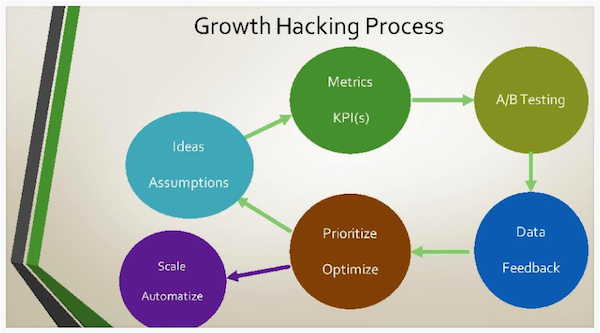
Why giving another growth hacking definition?
Before I start giving you my growth hacking definition, I would like to tell you why I want to define growth hacking by actually redefining the concept. In the startup world, I noticed that you can find an immense amount of resources about growth hacking; there are countless incubators, boot camps, books, webinars, accelerators, consultants, mentors, experts, gurus, ninjas and more who keep explaining to you how you should grow your startup by using growth hacking methods.
Ever since we launched our website Growth Hackers, people from all around the world have contacted us. They either asked us to help them, or wanted to get more information about growth hacking. The problem is that they do not necessarily get the responses they expected from us. In fact, many entrepreneurs or marketers contacted us by using their own definition of growth hacking based on what they’d heard.
Upon doing some research, we have found out that the concept of growth hacking is not well explained, or highly inaccurate; especially on the Internet. (Even if it is accurate or well explained, it’s lost in the middle of all the junk). Moreover, we have found multiple definitions that contradicted with other websites. So, I am going to give you my “definitive” growth hacking definition (it’s ok if you disagree; a lot of people do actually. Please write a comment below, contact me or send me a tweet about it. I am not saying that this definition is perfect; it’s just what I believe growth hacking is). Let’s define growth hacking.
What growth hacking is not
I want to start by talking about what growth hacking is NOT because I hear a lot of rumors or stories about it.
Growth hacking is not a magic formula. Growth hacking is not a few lines of code that you include on your website or your app to get millions of visitors or downloads overnight. If it was that easy, I would make an app in one day, put this code, get millions of downloads, sell the app and retire to French Polynesia.
Most people know that growth hacking is not that easy but I was surprised when people started contacting me and asked me to get them 10,000 app downloads a day for each country they were in + getting 4 million email addresses of relevant and interested people for their product within a year for each country (This is a true story, I literally had someone giving me those numbers explaining this is what growth hacking is all about).
First of all, 10,000 app downloads a day (Not impossible by the way) means nothing if people uninstall the app after. If you have 10,000 app downloads but 9,900 uninstall it within a month, then you actually have 100 real downloads (Or 100 new MAU – Monthly Active Users). But if you have 1,000 downloads but only 100 uninstall it, then you have 900 actual downloads. Don’t focus on quantity, focus on quality. If you want quantity, buy downloads from click farms in India or Bangladesh. But, be aware that retention is as important as (if not more than) acquisition.
Growth Hacking is not Computer or Software Hacking even if sometimes they can overlap. The goal is to hack growth, which means getting substantial growth the quickest way possible with a limited budget or tools. If I find out that the best way to growth hack your startup is by giving flyers at the airport: then, this tactic becomes a growth hacking strategy for your startup because I found that handing out flyers hacked your growth.
Many people often believe that growth hacking is obviously linked to computer hacking. Sorry to disappoint you but this is not always the case. You can hack computers or you can hack growth as well as many other things such as travel hacking, cooking hacking, life hacking or almost anything you can think of. Hacking or to hack is finding a way to manage/succeed in something within a low budget and/or with a limited number of tools. If you were born in the 70s or 80s, you probably know Mac Gyver, he was the life hacker of my childhood. If you don’t know the series, watch it and you will see that hacking is not only about IT.
Growth Hacking is not the same as traditional marketing even if traditional marketing strategies are often used in growth hacking.
Growth Hacking is not just a buzz word in the startup world, this is here to stay.
Growth Hacking is not unethical even it can be used in an unethical way by some people. If I make you purchase a product you like, It’s not unethical.
What growth hacking really is?
This is the part you were waiting for… it’s coming; you’re going to discover (If you don’t know it already) what the ‘real’ growth hacking definition is.
Growth hacking is a mix between marketing, engineering, data analysis and madness. Sure, you’ve heard that one before. You’re not so impressed I guess. Let’s go deeper then.
Growth hacking is a set of cross-disciplinary skills with 1 goal and 1 goal only: to grow a startup or a business. This means the only focus of a growth hacker is Growth, Growth and Growth. The ultimate goal is to find a predictable, repeatable and scalable growth process. Therefore, growth hacking is a process. And this is this process that many companies used to find new growth hacks. What people often forget when reading about successful growth hacking examples like Uber, AirBnB or Facebook, it’s that it took a long learning process before finding an effective growth hack.
The growth hacking process can be applied either when you are building a startup from scratch or when your business is more advanced. Let’s now divide the process into steps.
Metrics / KPI(s)
First, it’s important as a startup to choose which metrics or KPIs (Key Performance Indicators) to focus on. Each startup needs to have its own metrics.
For example, Facebook uses the number of monthly active users, Whatsapp the number of messages sent a day, Youtube the number of videos watched, Uber the number of rides… So, your metrics can be unique but be careful to not choose vanity metrics (I mean metrics that can be easily blown up in terms of numbers, or are irrelevant). The example I mentioned above about the daily number of downloads is a vanity metric if everybody uninstalls your app right after installing it. Another example; the number of social media fans is a vanity metric. A better metric would be the number of sales; you could then for example, focus on the conversion rate of your Facebook ads rather than the number of likes.
Once you have chosen which metrics to choose, you can start the growth hacking process accurately.

Channels Prioritisation
In order to bring growth, a growth hacker has many channels he can use: SEO, SEM, Social Media (SMO, SMM), Content Marketing, PR, Email Marketing, online/offline event organizations, Video marketing, ASO, referral marketing (Viral Growth), UI/UX, gamification, business development/strategic alliances, Sales… Having an effective sales and marketing strategy in place is what can make your startup go from failure to success.
I recommend the book Traction explaining you 19 different channels you can use for your startup. The book doesn’t describe each channel in detail but it gives a good overview of what you can do. I also believe that growth hacking goes hand-to-hand with the implementation of an inbound marketing strategy. If you are not sure what inbound marketing is, I invite you to read the inbound marketing definition.
But, what should you do with all those channels? The thing is, each startup or business is different. Each industry is different. Their target is different (B2B or B2C, different demographics, habits, location, culture, language, religion…). So, you might ask how a growth hacker would know which channels they should be using. A great growth hacker would say that they wouldn’t know the answer… unless they conduct a customised testing process for your startup. Even if you are the founder of your company, do you really know which channels are the most effective to use to reach your target audience before testing them? No, absolutely not.
Ideally, the goal would be to actually try all the existing channels. As a startup, you can’t. Then, you actually need to make assumptions, check what kind of competition there is on the market, define a marketing strategy, trust your gut feeling in order to choose which channels you will prioritise and test first.
A/B testing / Experimentation
In my opinion, A/B Testing is the most important part of growth hacking. Experimenting is really what define growth hacking. You have to be determined that you need to test everything. It’s impossible to know if something is going to work without testing it. You can make assumptions but at some point, you have to test those assumptions.
So, you have to test several channels but also A/B test those channels. What I mean is that you need, for example, to test social media, email marketing, PR and online events. But then, you also need to A/B test those channels. To illustrate this more clearly, let’s say you want to reach your target customers through social media. You can use Facebook, Twitter, Instagram, SnapChat, LinkedIn, Pinterest, Tumblr, Weibo or any social media channel that exists under the moon. Let’s assume you use Instagram. You need to A/B test to find out what works the best. Post different kind of pictures, different hashtags, post at different times, follow different people… This process should be the same for other channels, either you want to create great email marketing campaigns, compelling blog posts, work on your mobile app ASO, etc…
The goal is to literally test every single little detail until you find what works. It’s critical to include relentless experimentation to the growth hacking process. I will give more insights about A/B testing in another post.
Data Analysis / Analytics
Growth hacking is nothing without analytics. Without data analysis, growth hacking would be ineffective. You need to be able to track what you’re doing. Every action you take needs to be trackable, if you can’t, then you cannot see results and you cannot improve your strategy. Having a data-driven mindset is crucial.
There are so many ways to track your tests. For each channel, there are different ways. For instance, if you’re using email marketing, MailChimp is great. If you’re using PR, the way to track would be the number of reviews or the number of bloggers/journalists answers. For those data, you also need to come up with and define your own metrics (KPIs).
Users’ feedback
Users’ feedback is extremely important. During A/B Testing, you need to get feedbacks from users. Sometimes it can be annoying to get feedbacks, especially when it’s negative but it is crucial to improve your product and make it more user-centric. Negative feedback is the most important actually. You need to take care of unhappy users/customers, they are the best ones. Why? 96% of unhappy users leave your product without telling you why, which means you most likely won’t know what was wrong. The 4% telling you why, explain you and allow you to improve your product, which means they can become evangelists if they really like your product’s improvements. If they complain, it is usually because they need your product the most and they just want it to be perfect.
You don’t need to ask some experts or gurus about how to get more users for your product. You need to test. That so-called expert doesn’t know the details. Let’s say your startup sells a new software to ease the communication between you and your customers and remove the use of emails. The creator of Pokemon Go had a great experience because he made the game an incredible success. Of course, he can give you great input and recommendations. But, does he know your industry? Has he ever used your product? Does he know your customers? Probably not.
So, who knows? Are you the one to know? No. In fact, even you don’t know your product… I mean you don’t know your product as much as your users/customers do. Your customers know everything about your product. They use it every day. They like it, they know what’s wrong with it, they know what should be improved… So, listen to them. They have all the answers for you. Don’t waste your time and money talking to consultants. Spend that time and money for your users.

Optimisation / Prioritisation
Once you’ve analysed the data, you need to optimise and prioritise your channels and then you redo your A/B Testing. Don’t forget that testing is a cyclical process and crucial for your success.
Scalability / Automation
Once you have optimised your channels and improved your product, it’s time to scale. Scalability is an important part of the process. There are many ways to scale your startup (You can scale by going to a new market, automatizing your channels, there are a plethora of methods which are worth another post.)
It’s also time to automatize the process, channels, strategies and tactics. Watch out though, don’t waste your time automatizing something if you’re not sure it’s working.
Can you copy other startups’ growth hacks?
Some companies contact us and ask us to implement the same growth hacks that Dropbox, Airbnb or Candy Crush used. We tell them that we can implement the same process but not the same exact tactic. A growth hack that worked for another startup will probably not work for yours. The goal is to run the growth hacking process in order to find your own startup’s growth hack. Each startup will have a different way to grow and this is why there is an unlimited number of growth hacks.
The goal: Growth Hacking allows us to accompany your startup product development
The goal of growth hacking is growth but it doesn’t work by itself. The best marketer, growth hacker, designer, developer and data scientist working together will not make your product a success if your product doesn’t meet users’ requirements and the market needs.
The goal of growth hacking is to accompany your startup’s product development. The combination of an acquisition strategy, A/B testing, channels’ optimisation, data analysis and user’s feedback are meant to grow the product. This is why growth hacking is not the same as traditional marketing because a growth hacker is involved in engineering and product development. Working on retention and product development is an essential part of growth hacking and this is what a lot of people forget when they give their growth hacking definition. Therefore, growth hacking is not only to focus on acquiring growth but also ensuring the product’s growth. A growth hacker is a multi-talented individual and a growth hacker job description involves knowledge and experience in fields like marketing, data, engineering and product development.
What did we learn about growth hacking?
So, this was my growth hacking definition. As you can see, this is not magic. This is a process where you need marketing channels, data analytics, A/B testing, track & analyse the results, optimisation, automation and scalability. Growth hacking goes further than marketing because a growth hacker also works with the engineering & product development team in order to grow your product as well as users’ acquisition.
The process I mentioned is just the tip of the iceberg. A growth hacker has many tactics and tools to implement each step of the growth hacking process. Also, this is important to note that growth hacking can be used outside of the startup world. For instance, Donald Trump used growth hacking in politics to win the US elections 2016.
[This post by Jonathan Aufray first appeared on GrowthHackers and has been reproduced with permission.]


























